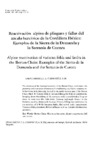Reactivación alpina de pliegues y fallas del zócalo hercínico de la Cordillera Ibérica: Ejemplos de la Sierra de la Demanda y la Serranía de Cuenca

View/
Use this link to cite
http://hdl.handle.net/2183/6178Collections
Metadata
Show full item recordTitle
Reactivación alpina de pliegues y fallas del zócalo hercínico de la Cordillera Ibérica: Ejemplos de la Sierra de la Demanda y la Serranía de CuencaAlternative Title(s)
Alpine reactivation of variscan folds and faults in the Iberian Chain: Examples of the Sierra de la Demanda and the Serrania de CuencaDate
1994Citation
Cadernos do Laboratorio Xeolóxico de Laxe, 1994, 19: 119-135 ISSN: 0213-4497
Abstract
[Abstract] The structure of the Variscan basement of the Iberian Chain conditioned the geometry and orientation ofstructures formed during the Alpine compression. In the Sierra de la Demanda, located in the north-western part of the Iberian Chain, the E-W Variscan folds re-activated during the Tertiary compression, bringing about the folding of the mesozoic rocks uncomformably lying on them. In sorne sites this folds broke, forming high-angle thrusts. In the
Boniches anticline (Serranía de Cuenca), Tertiary folding was conditioned by
the existence of NW-SE basement faults, that moved under transpression. Variscan folding directions did not influence here the Tertiary deformational
geometry.
Keywords
Iberian Chain
Hercynian basement
Alpine compression
Fold reactivation
Hercynian basement
Alpine compression
Fold reactivation
ISSN
0213-4497





